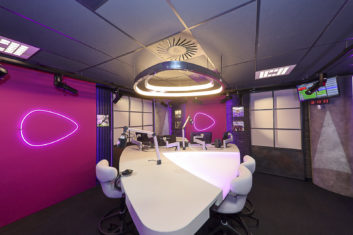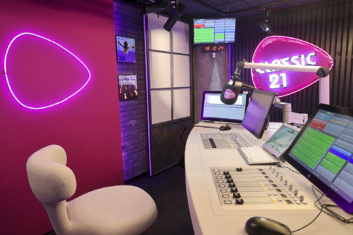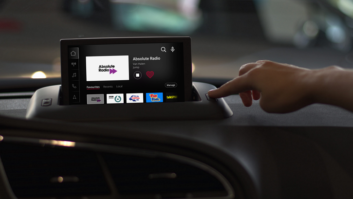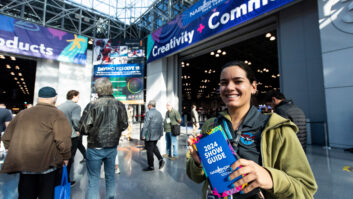MONS, Belgium — RTBF officially opened new studios on Jan. 21 at its regional center in Mons.

With the existing radio studio infrastructure dating back from 2006, the broadcaster decided to construct and modernize its new broadcast studios with a view toward future visual radio operation.
“The project consists of four radio studios,” said Hélène Ronveaux, RTBF Radio project manager. “A first studio serves the VivaCité’s DAB+ channel Viva+. A second operates as production and interview studio for Classic 21. We finalized both studios in September last year. This allowed us to use the new Classic 21 studio as stand-in during the renovation of Classic 21’s main on-air landscape.”

In addition to the new Classic 21 on-air studio, the Mons site will also accommodate a brand new on-air studio for VivaCitéMons, expected to be operational this fall.
THE CLASSIC 21 UNIVERSE
The first plans for Classic 21 were for a functional studio, but without the station’s identity. “So we started designing from scratch — we wanted a visitor to know that he or she enters the Classic 21 studio without seeing the logo or hearing the music,” said Etienne Dombret, editorial director of Classic 21.
“The input from our staff was essential, everybody had to feel well in the studio — some presenters have to work five consecutive hours in the same room. This studio was also the broadcaster’s first studio that was completely designed, assembled and cabled by RTBF’s design, integration and engineering specialists, both from radio and television.”

Classic 21’s radio team brought in record covers and instruments to decorate the studio walls, creating a cozy “bar” atmosphere, enhanced by a Chesterfield sofa.
“Our presenters and engineers also wanted to have windows looking out on the city of Mons from the main ‘Laforge’ (honoring the station’s morning drive presenter Eric Laforge who passed away Feb. 15) studio,” continued Dombret.
“In view of our visual radio plans, we installed sliding glass doors. Also, some walls were covered with brick strips over the existing acoustic elements like bass traps.”
The smaller production facility was equipped as an interview studio with room for a presenter and three guests.
“Both the studios and hallway between them breathe the same atmosphere — the hallway is decorated with photographs of artists that have visited us, like Joe Cocker or Aerosmith. Everything is part from the same universe,” Dombret said. “The whole is visually very attractive and, when COVID-19 is over, this studio landscape will offer us many more possibilities for visual radio content. Classic 21 has become very telegenic.”
IP CONNECTIVITY
The new radio infrastructure uses a DHD XC2 platform, a single backbone serving the four 52/MX consoles in the new studios with separate XC2 cores. An extra XC2 core is used for the functionalities in the master control room and the Dante connections with the production and editing cells.

“In 2016, with the renovation of the La Première radio studio, we issued a rulebook for technical installation,” explained Ronveaux.
“Based on these specifications, RTBF decided to invest in DHD radio systems. Today, we use the brand in various on-air studios and regional centers. The fact that we’ve implemented the same philosophy in all studios increases our technical staff’s mobility. They can work from different studios with an identical technical setup.” RTBF has continued to use the Netia AirDDO playout system.
Both the Viva+ and Classic 21 production facilities were designed as self-op studios, with 12-fader 52/MX desks, the (also self-op) Laforge studio has a 14 fader desk — every studio offers room for a presenter and three guests.
The Mons radio site is now directly connected over IP with the main RTBF broadcast center in Brussels using AES67/Ravenna technology.

“This is really unique — in the past, we had four 2 Mbps links with Brussels, each for the equivalent of five mono sources or two stereo and one mono source. With AES67/Ravenna connectivity, and DHD’s XC2 AES67/Ravenna interface, we have drastically boosted our transmission capacity. Today we have 64 channels plus an extra 64 channels as backup,” said Ronveaux.
“Every console uses multiple channels. All signals from the four studio’s are routed to master control room in Brussels. It’s equipped with a Lawo AES67/MADI converter to connect with our central Mandozzi IDEA audio router.” In the main matrix in Brussels, the Mons signal is mixed with advertising and time signal and aired on the RTBF transmitter park.
VISUAL RADIO OPTION

Bearing in mind the future visual radio option, RTBF paid a lot of attention to the imaging and decoration of its new on air studios.
“The studios were conceived as ‘visual ready,’ with video as part of the design. Pending the installation of fixed cabling and cameras, Classic 21 is using a handheld camera in the new studio landscape,” Ronveaux continued.
DHD distributor Amptec managed the installation and basic configuration of the DHD 52/MX system and the tailor-made studio furniture. “The challenge was, in close collaboration with the RTBF’s network and radio technology experts, to parameterize the DHD configuration for ease-of-use and stability, in a thorough and advanced IP-setup,” said Bart Lamberigts, Amptec project manager.
For the visual radio aspect, Amptec also supplied customized, visually attractive microphone arms and Yellowtec components. “Classic 21’s new studio is one of the most beautiful on-air facilities we’ve worked on,” Lamberigts continued. “RTBF is extremely strong in designing and building appealing studio environments with internal staff.”

Etienne Dombret is confident about the future. “Personally, I think consolidating our current market share is crucial. We have grown from 3.9% to an overwhelming 10.9% in 15 years — 2019 was a record year,” he said. “I’m happy to see that we have succeeded in winning over a new and younger audience. With an enthusiastic team in spacious, efficient and visually appealing studios and new technology, we are also devising new program concepts.”
At press time, the VivaCité on air studio was still under construction, and expected to be operational this fall.
During renovation, VivaCité is broadcasting from a provisional studio with a Studer setup.







